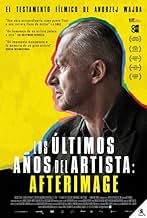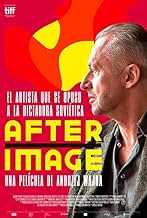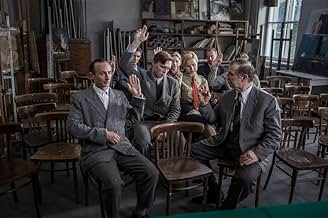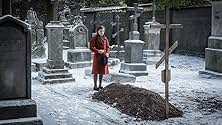The story of charismatic painter Wladyslaw Strzeminski, who opposed social realism and maintained his own artistic freedom in spite of political obstacles.The story of charismatic painter Wladyslaw Strzeminski, who opposed social realism and maintained his own artistic freedom in spite of political obstacles.The story of charismatic painter Wladyslaw Strzeminski, who opposed social realism and maintained his own artistic freedom in spite of political obstacles.
- Director
- Writers
- Stars
- Awards
- 2 wins & 12 nominations total
- Director
- Writers
- All cast & crew
- Production, box office & more at IMDbPro
Featured reviews
In the very first scene, we see Strzeminski in a beautiful green meadow, teaching his pupils how to paint a landscape. When a new pupil presents herself, he literally rolls down the hillside to meet her - in spite of his disabilities: he misses one leg and one arm. Strzeminski is happy and upbeat. During the film, this proud man slowly transforms into a human wreck. At the end, he is no longer able to stand on his feet, let alone roll down a hillside.
Bit by bit, the communists make his life impossible. In a visually stunning scene, all light in his apartment turns red, because of a giant Stalin banner which is attached over his window. Furious, because he is no longer able to paint in natural daylight, he tears the banner with one of his crutches. It's the start of a fight against the system that turns out to be futile.
Director Andrzej Wajda, who died last year, shows Strzeminski as a man who lives for his art, and for nothing else. Even his teenage daughter is forced to move to an orphanage, because he doesn't seems to be interested in raising her. Wajda shows Strzeminski's weaknesses, but also his opponent's doubts. Many of them somehow sympathize with him, but are unable to show support without risking their own position. An example is the manager of the local museum, who cannot display his paintings, but carefully keeps them in storage.
Parallel with Strzeminski's decline, we witness also Poland's transformation from a proud nation into a Soviet-dominated satellite state, where communist propaganda is everywhere and the quality of life deteriorates rapidly. In one scene, Strzeminski is turned down by a shop selling painting materials, because his membership of the artist's union is withdrawn. He hides his disappointment and takes his daughter to the cinema. But there he finds out he has to watch Soviet propaganda. Disgusted, he leaves the theatre.
'After Image' shows an important episode of Poland's artistic history. At the same time, it is a warning against any totalitarianism, and an ode to artistic freedom.
The last movie of Andrzej Wajda tells the story of one of the best artists of the 20th Century, Wladyslaw Strzeminski.
The movie states that the situation of a true artist is miserable in spite of the geography, language and culture. Wladyslaw Strzeminski is a great painter, and is suffering due to his personal views, during a great social reformation in Poland. He loose his job, artist license canceled, and ignored in every corner of life. Though his students try to support him, it doesn't make much use. Hungry and sick, a great artist faces the tough realities of life.
The performance of the cast are amazing. Boguslaw Linda as Strzeminski and all the remaining cast have done a wonderful job. Photography and direction is so superb.
I noticed the audience after the movie, they had tears in their eyes. It is so heart touching. Do not miss this movie, if you are a real movie freak!
Humorous, surprising, and informative, Dr. Peterson tells us why skateboarding boys and girls must be left alone, what terrible fate awaits those who criticize too easily, and why you should always pet a cat when you meet one on the street.
What does the nervous system of the lowly lobster have to tell us about standing up straight (with our shoulders back) and about success in life? Why did ancient Egyptians worship the capacity to pay careful attention as the highest of gods? What dreadful paths do people tread when they become resentful, arrogant, and vengeful? Dr. Peterson journeys broadly, discussing discipline, freedom, adventure, and responsibility, distilling the world's wisdom into 12 practical and profound rules for life. 12 Rules for Life shatters the modern commonplaces of science, faith, and human nature while transforming and ennobling the mind and spirit of its listeners.
The film scenes are precise and the transitions between them are remarkably fluid, scary good! The acting is exemplary. The actors are cast perfectly, especially the main actor and the young woman who portrays his long-suffering daughter. Such wonders are the marks of a masterful director. Wajda died just after the completion of the film. Wajda was the trusting sort, said a friend of his, just before the film began. Such trust in his crew paid dividends. Seen at the Miami International Film Festival.
It was crazy how they used the system to basically suppress him as the qualifications to work in his country were ridiculously and being crippled met that he did not meet enough standards to receive a stamp on his work Visa that said he could work as an artist. The art store would not even sell him paint if he did not have his work ID. So this guy wanted to work and was more than capable of being an artist despite his limitations, but they would not simply because his thoughts went against what was popular at the moment.
I find it interesting that movies about the events around World War II seem to be popping up a lot. My first thought was that people are getting tired of movies about Iraq or Afghanistan like possibly people got tired of the constant references of Vietnam in every 1980s TV show, but I'm starting to think that's not the case. Even though life in the present is no where near as hard as what they went through back then, I'm noticing some trends from yesteryear coming back into fashion and these movies are used to keep in are minds fresh the idea that those who do not know history are doom to repeat it.
I don't know if this story is based on truth, but it's definitely inspired by things that did happen, which makes it a very educational film, but at the same time it was very entertaining, with great acting and very good visuals. The relationship between the painter and his students was very colorful. Afterimage does a great job at hinting at things without hitting you over the head with it, which I liked.
Not what I was expecting when going to the theater, but well worth watching.
http://cinemagardens.com
Did you know
- TriviaOfficial submission of Poland for the 'Best Foreign Language Film' category of the 89th Academy Awards in 2017.
- Quotes
Wladyslaw Strzeminski: They praise the ones who suck up. They're silent about the real artists.
Julian Przybos: I spoke about this with Milosz. He also believes that an artist who can't speak with a full voice should be silent. Artists can be killed in two ways: either by talking about them too much or not at all.
- ConnectionsReferences L'homme de marbre (1977)
- SoundtracksLandscape
Written by Andrzej Panufnik
Performed by Narodowa Orkiestra Symfoniczna Polskiego Radia w Katowicach
Conducted by Piotr Komorowski
- How long is Afterimage?Powered by Alexa
Details
Box office
- Gross US & Canada
- $33,443
- Opening weekend US & Canada
- $5,832
- May 21, 2017
- Gross worldwide
- $1,032,768
- Runtime1 hour 38 minutes
- Color
- Sound mix
- Aspect ratio
- 2.35 : 1
Contribute to this page



































